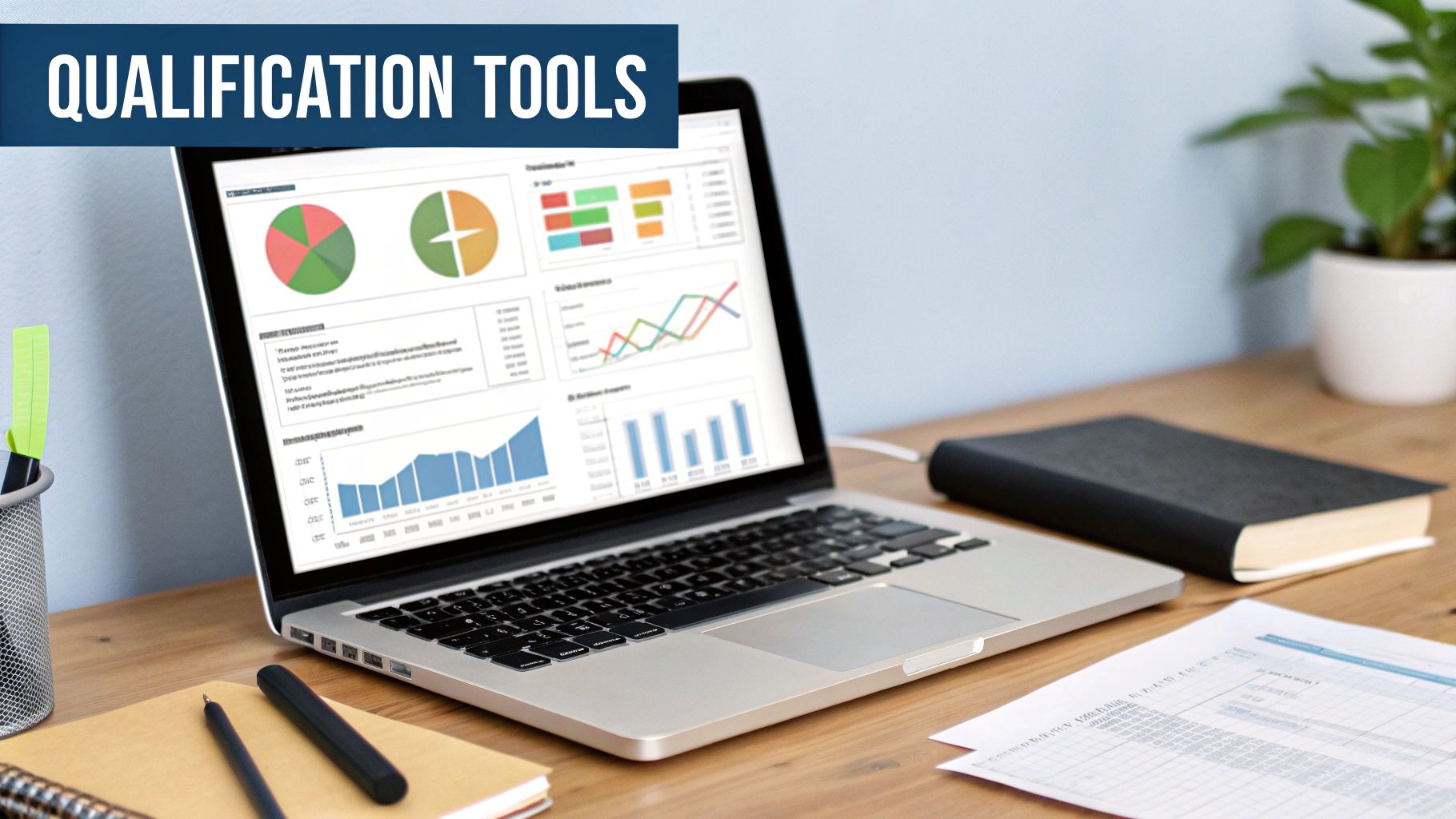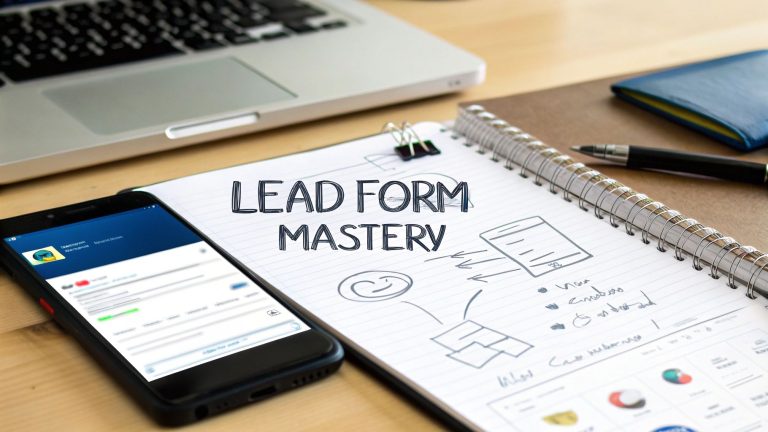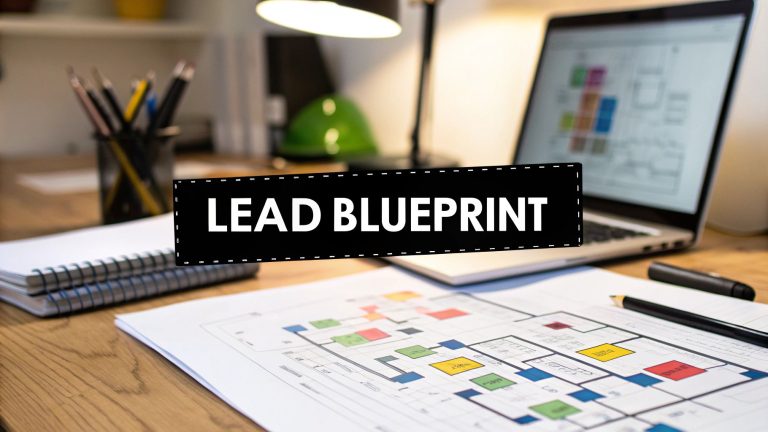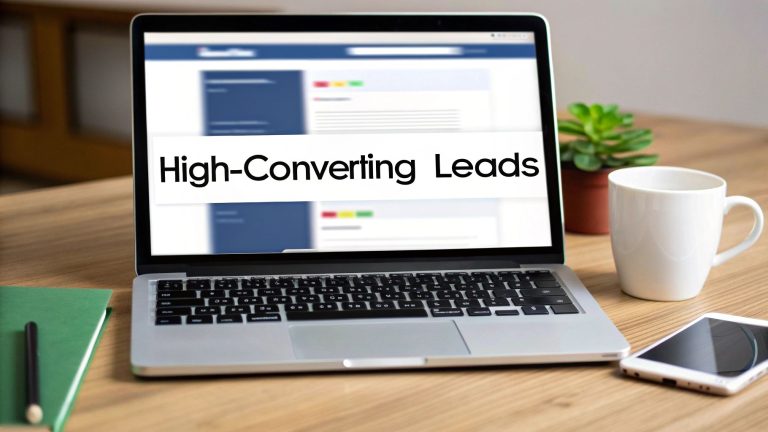What Is Lead Qualification? Your Conversion Roadmap
What Is Lead Qualification? The Game-Changer Behind Sales Success

Have you ever felt like your sales team is stuck in a loop of dead-end calls? The secret to breaking that cycle isn't always about working harder—it's about working smarter. This is where lead qualification comes in. Think of it as a powerful filter for your sales pipeline, helping you identify which prospects have the best chance of becoming paying customers. Instead of chasing every single name that comes through the door, you focus your energy on those who are a genuine fit for your business.
This process marks a critical shift from lead generation, which often prioritizes quantity, to a smarter approach focused on quality. It's the essential bridge between your marketing efforts and the sales conversations that actually drive revenue. Without a solid qualification process, your sales reps waste precious time. In fact, studies show that 67% of lost sales happen because leads weren't properly qualified from the beginning, proving just how crucial this step is for efficient growth.
Defining Your Sales Compass
At its heart, lead qualification is like a compass for your sales team. It points them toward prospects who not only have a problem your product solves but are also in a position to actually buy. The process involves measuring leads against a specific set of criteria to sort them into clear categories:
- Unqualified Leads: These are a poor fit and should be removed from your active pipeline.
- Nurture Leads: Prospects who could be a good fit in the future but just aren't ready to buy right now.
- Sales-Qualified Leads (SQLs): High-potential prospects who are ready for a direct conversation with your sales team.
This sorting system is incredibly powerful. For instance, a recent analysis of nearly 1,900 leads showed that a stunning 80% were classified as marketing-qualified leads (MQLs), meaning they showed strong initial interest based on marketing interactions. This shows how qualification effectively separates the serious contenders from the crowd, letting your team concentrate their efforts where it counts. By putting a strong lead qualification framework in place, you build a predictable and successful sales engine.
Creating Your Ideal Customer Blueprint: The Foundation That Changes Everything
Before you can decide if a lead is a good fit, you first need a clear picture of what "good" actually means for your business. This critical first step involves creating an Ideal Customer Profile (ICP), which serves as a detailed blueprint of your perfect customer. This isn't just a marketing exercise; your ICP is the true north for your entire qualification process, ensuring both sales and marketing teams are hunting for the same prize. It prevents the common problem where marketing celebrates high lead numbers while sales is stuck with low-quality conversations.
Think of it like building a house. You wouldn't just start laying bricks without a detailed architectural plan. In the same way, you can't build a strong sales pipeline without a clear vision of the customer you're building it for. The best way to draft this blueprint is by looking closely at your current happy customers—the ones who get the most value, stick around the longest, and recommend your brand to others.
Decoding Your Best Customers
To get started, look for the common threads that connect your most successful accounts. The lead qualification journey often begins by analyzing these top customers to map out their key characteristics. This initial analysis helps your teams prioritize leads with the highest potential right from the start. You can learn more about why defining an ICP is a crucial first step by exploring insights on lead qualification strategies.
Ask yourself these important questions to uncover the patterns:
- Firmographics: What industries are they in? What is their typical company size or annual revenue? Where are they located?
- Pain Points: What specific problems did they face before they found you? What challenges was your product or service able to solve for them?
- Buying Behavior: How did they discover your business? What did their decision-making process look like? Who was involved in the final purchase?
A Living, Breathing Document
Once you have this information, you can assemble a detailed profile. For example, a B2B software company might find its ICP is a US-based tech company with 50-200 employees that is struggling with inefficient project management. This level of detail turns qualification from a guessing game into a methodical process. The data you use to build and manage this profile is often stored in your company's core systems. For a closer look, check out our guide on how a CRM can support lead generation and profile management.
Most importantly, the best companies treat their ICP not as a static document but as a living one. As your business grows, your product changes, and the market shifts, your ideal customer will also change. Make it a habit to regularly review and update your ICP using new sales data and customer feedback. This keeps your qualification compass perfectly calibrated, ensuring you always focus on the leads most likely to become your next best customers.
Lead Scoring That Actually Predicts Success

So, you have your Ideal Customer Profile (ICP), but how do you sort through the dozens, or even hundreds, of leads that seem to fit? Instead of relying on gut feelings, sales teams now use lead scoring to bring data-driven clarity to the qualification process. Think of it as giving each prospect a score based on who they are (demographics) and what they do (behaviors). This system immediately shows your sales team which leads are hot and deserve their attention right away.
This method turns lead qualification from a guessing game into a calculated science. For instance, a lead who matches your ICP’s industry and company size might get 15 points. If they also download a case study, you can add another 10 points. If they visit your pricing page—a strong buying signal—that could add 20 more. By assigning a numerical value to these traits and actions, you create a clear hierarchy of sales-readiness.
Balancing Demographics With Behavior
A common mistake is putting too much weight on demographic data alone. While knowing a lead’s job title or company revenue is useful, their behavior often tells a much richer story about their intent to buy. A C-level executive from a perfect-fit company is still a cold lead if they show zero engagement with your brand. On the other hand, a manager from a smaller company who actively interacts with your content could be a hidden gem.
This is why behavioral scoring is so important. These actions signal active interest and are strong predictors of where someone is in their buying journey. The best sales teams recognize this and weigh engagement signals heavily in their scoring models. A major development here is the rise of Product-Qualified Leads (PQLs). A PQL is a prospect who has already used your product, often through a free trial or freemium model, and has taken specific actions that show they find it valuable.
For a SaaS company, a PQL could be someone who has:
- Invited three teammates to their account.
- Used a key feature five times.
- Integrated your tool with another platform.
These leads are often the most valuable because their actions speak louder than any form submission ever could.
To help you visualize how these different methods compare, here is a breakdown of common lead scoring frameworks.
Lead Scoring Framework Comparison
| Scoring Method | Key Factors | Optimal Score Range | Conversion Rate | Best Use Case |
|---|---|---|---|---|
| Demographic Scoring | Job title, company size, industry, location, revenue | 20-40 points | Low to Moderate | Initial filtering to ensure leads match the basic ICP. Good for broad B2B markets. |
| Behavioral Scoring | Website visits, content downloads, email opens, webinar attendance | 40-75 points | Moderate to High | Identifying actively engaged leads who are researching solutions. Ideal for content-heavy marketing. |
| Product-Usage (PQL) | Feature adoption, trial usage frequency, inviting team members, upgrade actions | 60-100+ points | Very High | Converting free trial or freemium users into paying customers. Best for SaaS and product-led growth models. |
This table shows that while demographic scoring is a good start, layering in behavioral and product-usage data provides a much clearer picture of a lead's potential.
Recent data confirms the power of a well-tuned system. It has identified a ‘lead-scoring sweet spot’ between 41 and 60 points, where prospects are most likely to convert. This quantitative approach helps prioritize sales efforts with incredible accuracy. You can explore more data about lead generation benchmarks by checking out the full statistics on Databox.com.
Battle-Tested Qualification Frameworks That Work
While an Ideal Customer Profile tells you who your best customers are, qualification frameworks give you a map for the conversation. Instead of starting from scratch, top-performing sales teams use proven models to guide their discovery calls. These aren't rigid scripts, but flexible guides to ensure you gather the essential details to know if a lead is truly ready for sales.
Think of a framework as a conversational checklist. It keeps you focused on what really matters, turning a vague chat into a strategic assessment. When used correctly, these frameworks help you uncover a prospect's situation without making them feel like they're being grilled. This approach builds trust by showing you’re genuinely invested in understanding their problems.
The Classic: BANT
One of the most enduring frameworks in sales is BANT, which stands for Budget, Authority, Need, and Timeline. Developed by IBM decades ago, its lasting power comes from its simplicity. It’s a fantastic starting point for any team trying to get a handle on what is lead qualification.
Here’s how BANT helps structure your discovery process:
- Budget: Does this prospect have the financial capacity to buy your solution? This is more than just asking for a number; it’s about understanding their financial situation and how much they value solving their problem.
- Authority: Are you speaking with the person who can sign off on the purchase? If not, who else needs to be part of the discussion to make a decision?
- Need: What is the fundamental business pain they need to fix? A strong, clear need is the most important piece; without it, the other factors don’t matter.
- Timeline: When are they hoping to have a solution in place? Knowing their timeline helps you measure their urgency and prioritize your follow-up.
BANT provides a solid foundation by making sure you cover the basic pillars of any potential deal. It’s especially helpful for sales with a shorter, more direct decision-making process.
The Challenger: MEDDIC
For more complex B2B sales involving large accounts and multiple decision-makers, many top teams turn to the MEDDIC framework. It provides a more detailed and strategic way to navigate complicated buying committees.
Here’s a breakdown of what each letter in the MEDDIC framework represents:
| Letter | Stands For | Key Question to Answer |
|---|---|---|
| M | Metrics | What are the measurable business results the prospect wants? (e.g., boost revenue by 15%, cut operational costs by 20%) |
| E | Economic Buyer | Who holds the final authority and controls the budget to approve this purchase? |
| D | Decision Criteria | What specific technical and business requirements will they use to judge and compare different solutions? |
| D | Decision Process | What are the exact steps, timeline, and people involved in reaching the final decision? |
| I | Implicate the Pain | What are the negative outcomes and financial costs if they fail to solve their current problem? |
| C | Champion | Who is your advocate on the inside? This person believes in your solution and will sell it for you internally. |
While BANT helps you qualify an opportunity, MEDDIC is about building an undeniable business case. By focusing on metrics and pain, it helps you shift from being just another vendor to becoming a trusted partner in their success.
The 4 Stages of the Modern Lead Qualification Process
Think of lead qualification less like a single event and more like a relay race. Marketing runs the first leg, using technology to spot promising runners, and then passes the baton to sales for the final sprint to the finish line. This collaboration ensures your sales team invests their time in conversations that have a real chance of becoming wins.
Marketing's job is to act as the initial gatekeeper. They watch for behaviors that signal more than just casual curiosity. For example, when someone downloads a whitepaper and then immediately checks out your pricing page, that's a strong hint. Marketing automation tools flag this person as a Marketing Qualified Lead (MQL). This is a crucial signal that the individual is moving from passive interest to active consideration. A smooth handoff at this stage is vital; companies that master lead nurturing generate 50% more sales-ready leads at a much lower cost.
From MQL to SQL: The Human Element
Once marketing has identified an MQL, the process becomes more personal. The lead is passed to the sales team, where technology helps, but doesn't replace, human expertise. A lead becomes a Sales Qualified Lead (SQL) not just based on data, but after a direct conversation with a sales representative. In this call, the rep confirms critical details like budget, authority, and immediate need. This is where a person's intuition and ability to read between the lines make all the difference.
To better understand this journey, the table below breaks down the four key stages of the modern lead qualification process. It shows who is responsible for each stage and what activities and metrics define success.
| Stage | Owner | Key Activities | Qualification Criteria | Success Metrics |
|---|---|---|---|---|
| Stage 1: Lead Capture | Marketing | Generating interest through content, ads, and web forms. Collecting initial contact information. | A person provides contact details in exchange for content or information. | Volume of new leads, Cost Per Lead (CPL). |
| Stage 2: MQL | Marketing | Tracking engagement (website visits, email opens, content downloads). Automated lead scoring. | Lead meets a predefined scoring threshold based on their profile and behavior. | MQL-to-SQL Conversion Rate, Lead Score Accuracy. |
| Stage 3: SQL | Sales | Initial outreach call or email to verify information. Discovering specific needs and challenges using a framework like BANT. | The lead confirms a genuine need, budget, authority, and a clear timeline for purchase. | Number of SQLs Accepted, SQL-to-Opportunity Conversion Rate. |
| Stage 4: Opportunity | Sales | In-depth discovery calls, product demos, proposal creation. Mapping out a solution to the lead's problem. | A clear business case is established, and the prospect agrees to evaluate a formal proposal. | Pipeline Value, Win Rate, Sales Cycle Length. |
This structured process ensures that leads are consistently and effectively moved through the pipeline. The handoff from one stage to the next is a critical moment where momentum can be lost or gained.
The Role of Your CRM in the Qualification Journey
Your CRM is the command center for this entire process. By setting up automated workflows, you can make sure leads are scored, assigned to the right person, and tracked without ever falling through the cracks. For a deeper look at this, our article on automated lead nurturing explains how to build these efficient systems.
The goal is to use technology for what it does best—handling repetitive tasks with precision—freeing up your sales team to focus on what they do best: building relationships and closing deals. This combination of automated accuracy and a personal touch is the foundation of a successful modern qualification strategy.
Avoiding Qualification Mistakes That Kill Deals

Even with a solid process for what is lead qualification, promising deals can still fall apart. Sales professionals, often with the best intentions, can make small but costly errors during qualification that stop a deal in its tracks. These mistakes can quickly kill momentum and waste everyone's time.
One of the most common traps is mistaking politeness for genuine buying intent. A prospect might sound excited and agree to every meeting, but if you haven't confirmed their budget or decision-making power, you might just be giving away free advice. This clogs your pipeline with leads who will never become customers, hurting both morale and resources. In fact, research shows that 37% of sales reps spend over half their time on prospects who have a very low chance of ever buying.
Common Traps and How to Sidestep Them
Beyond chasing friendly but ultimately unqualified leads, other common mistakes can undermine your sales efforts. Recognizing these pitfalls is the first step to building a stronger, more effective qualification process.
Here are a few common mistakes to look out for:
- Confirmation Bias: This is the human tendency to hear only what you want to hear. You might focus on how much a prospect needs your solution while conveniently ignoring clear signs they can't afford it. The fix is to stick to your qualification framework and ask the tough questions, even if you’re afraid of the answer.
- Rushing the Process: In a hurry to push a lead to the next stage, it’s tempting to skip key discovery questions. You might get a quick "yes" for a demo, but you won't have the information needed to make that demo count. You need to slow down early in the process to speed up the sale later.
- Ignoring Red Flags: A prospect who constantly reschedules calls or dodges questions about budget isn’t just "busy"—they're likely unqualified. These behaviors are huge signals. The best sales pros know when to politely step back and focus on more promising opportunities.
The Problem of Premature Disqualification
On the other flip side, another major error is writing off a lead too soon. Just because someone isn't ready to buy from you today doesn’t mean they won't be a perfect customer in six months. A lead might not have the budget right now, but they could be in the middle of securing new funding. If you dismiss them, you might be handing a future sale directly to a competitor.
The trick is to learn the difference between "not a good fit" and "not ready yet." For prospects who seem promising but the timing is off, a lead nurturing sequence is the ideal approach. Studies reveal that nurturing can produce 50% more sales-ready leads over time. This strategy keeps your business top-of-mind, turning a "no for now" into a definite "yes" when the time is right.
Measuring What Matters: Qualification Metrics That Drive Results
You can't improve what you don't measure. In lead qualification, tracking the right numbers is the difference between teams that guess and teams that grow. While looking at basic conversion rates is a start, the most successful sales teams focus on leading indicators that predict future success and flag leaks in their pipeline before they become disasters.
These numbers go far beyond just counting how many leads you get. They show you the health and efficiency of your entire qualification process, pointing to exactly where you can make small changes for much better results.
Leading Indicators for Qualification Success
To truly understand what is lead qualification means in action, you have to track how well your team moves prospects through your funnel. Here are the key metrics that matter most:
- Lead-to-Opportunity Conversion Rate: This is your main qualification metric. It calculates the percentage of raw leads that successfully become qualified opportunities. A low rate might signal that your initial lead quality is poor or your qualification criteria are too strict.
- Sales Accepted Lead (SAL) Rate: This metric tracks how many marketing-qualified leads (MQLs) the sales team actually accepts and agrees to pursue. A low SAL rate often points to a gap between what marketing thinks is a good lead and what sales knows is a good lead.
- Qualification Velocity: How long does it take for a brand-new lead to become a qualified opportunity? A slow velocity can kill a lead's momentum and open the door for competitors. Tracking this helps you find and fix bottlenecks in your system.
- Qualification-to-Close Ratio: Of all the leads you qualify, how many actually turn into paying customers? This metric is the ultimate test of how accurate your qualification criteria really are.
For a deeper look at related measurements, you can check out our guide on essential lead generation KPIs that work alongside these qualification metrics.
Visualizing Your Performance
Using a dashboard to track these numbers gives you a real-time picture of your team's performance, allowing you to make quick, informed decisions.
Here is an example of what a sales performance dashboard might look like, tracking opportunities and win rates.
Visuals like this turn raw data into actionable insights, showing you at a glance where your team is excelling and where they need support.
Ultimately, measuring these specific parts of lead qualification gives you the data needed to continually fine-tune your process. It helps you move from hoping for good results to building a system that reliably produces them.
Ready to stop manually downloading leads and start acting on them instantly? LeadSavvy Pro automates your Facebook lead capture, sending new prospects directly to your CRM or a Google Sheet. Start for free and see how much faster you can qualify leads.







